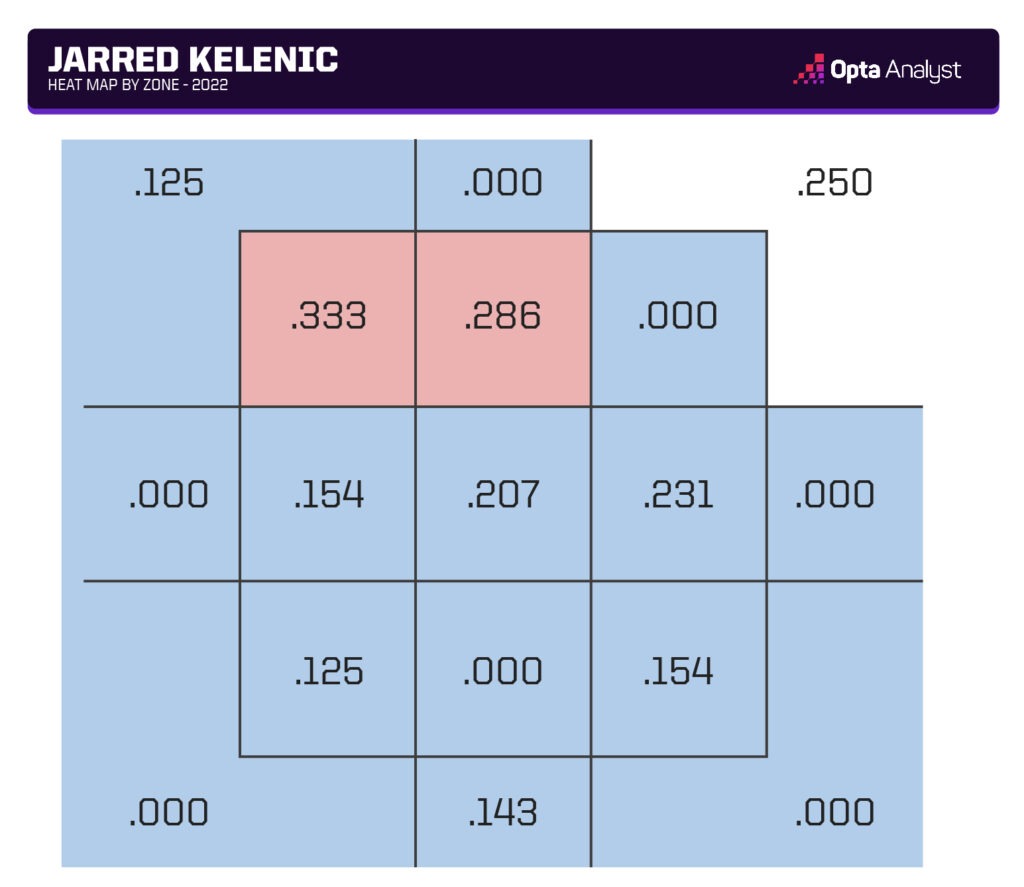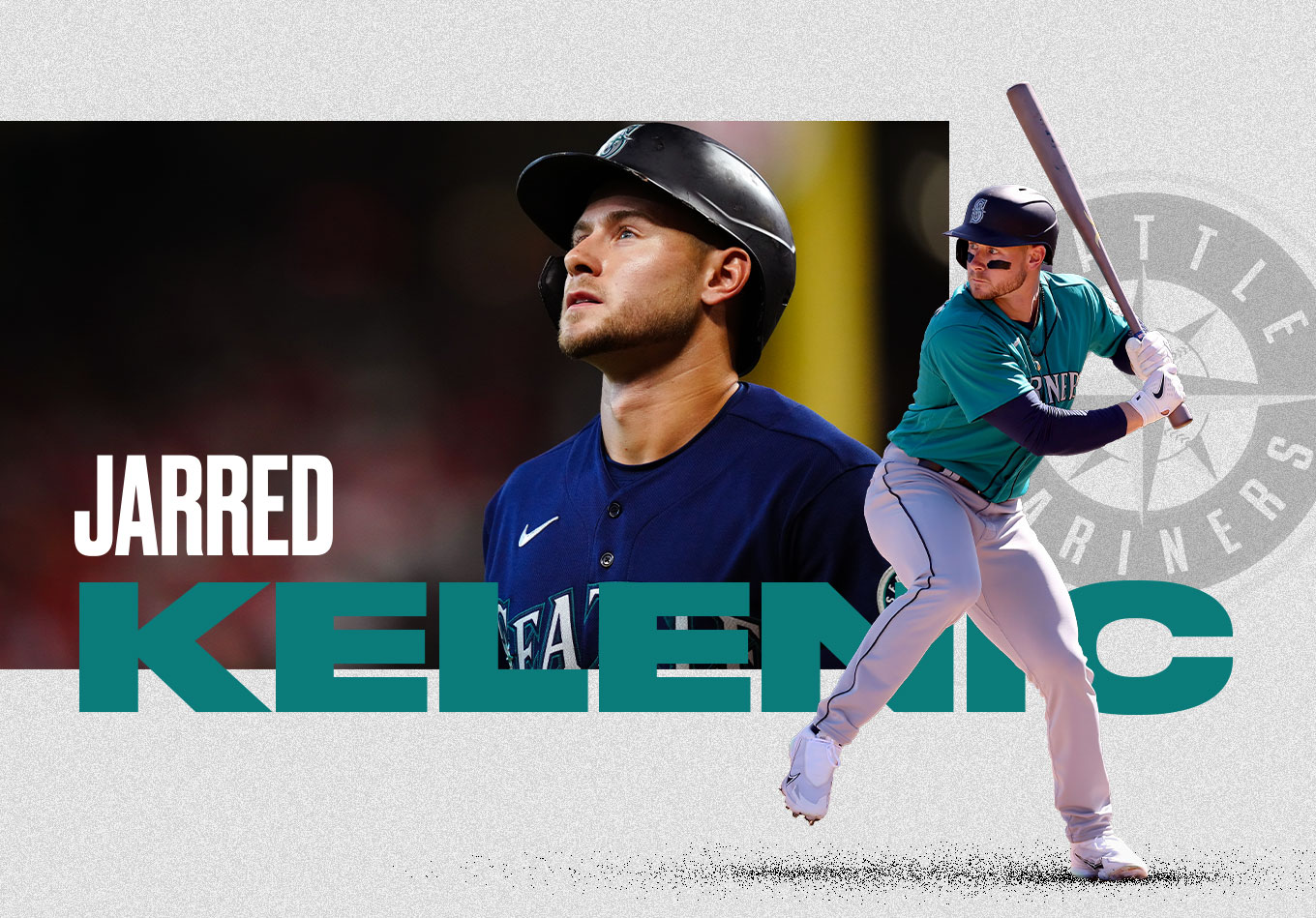For every explosive Triple-A stint, he’s fallen flat on his face at the MLB level.
Despite being universally regarded as a top-10 prospect for years, Jarred Kelenic hasn’t been able to establish himself as a major leaguer after several extended trials in 2021 and 2022.
Will this season be different? Well, the 23-year-old center fielder’s swing is different after he tinkered with it in the offseason (more on this later). It seemed to have worked early on as he put together a promising spring for the Seattle Mariners.
Kelenic slashed .353/.389/.706 with two doubles, two triples, four home runs and a 1.095 OPS. He did strike out 13 times with just three walks, but he was marvelous in March.
Can he take the next step and carry that performance into his third big-league season? That is the burning question. The results haven’t been encouraging through the first few games, as he’s gone 2 for 13 with six strikeouts (a 42.9% rate) in 14 plate appearances.
As a major leaguer, Kelenic has slashed .168/.250/.335 with 21 homers and 12 stolen bases. He has done that in 572 trips to the plate, which is roughly a season’s worth of plate appearances.
Kelenic’s struggles have several causes and ramifications. The most obvious one is that he can’t hit lefties, or hasn’t shown that ability yet. Of course, he hasn’t hit righties either during his brief MLB stint, but at least he has a .651 OPS against them. Southpaws dominate him to the tune of a .469 OPS.
That’s why Kelenic was out of the lineup Tuesday against Los Angeles Angels starter José Suarez. But as he said so himself (we’ll get there in a minute), he should focus on the things he can control for now and try to have competitive at-bats against righties in order to gain playing time against left-handers.
The other thing Kelenic hasn’t been able to handle is breaking pitches. To analyze his performance here, we will use a series of advanced stats like raw value+ (RV+), contact+, discipline+ and BIP+. For these, 100 is considered to be league-average performance.
RV+ examines a hitter’s performance on a per-pitch basis, rather than analyzing just the outcome of an at-bat. Plenty of things happen in the battle between a pitcher and a hitter, so why should we only stick with the final outcome? It combines plate discipline, quality and quantity of contact, but also other factors.
Kelenic’s RV+ last year, combining all pitches and plate appearances, was a brutal 57 in 181 trips to the plate.
We can also measure a batter’s ability to make contact (contact+), make sound decisions at the plate (discipline+) and how much damage he inflicts on contact (BIP+). Kelenic rated negatively in all of them: his discipline+ (95), contact+ (90) and BIP+ were all comfortably below average.
Pitchers had their way with him, forcing him into bad swing decisions and less-than-ideal contact.
His performance against breaking balls was particularly worrisome. By RV+, he did well against both two and four-seam fastballs thrown by righties (388 and 116, respectively, keeping in mind small sample-size caveats), but he struggled mightily against every other pitch in the book – versus both southpaws and righties.
He even had some negative RV+ values – yes, it is possible – against many pitches thrown by lefties, including curveballs (-113) and sliders (-10).
If we examine his 2022 performance by zones, the landscape isn’t more promising. In total, he saw 698 pitches last year and had a mediocre 69.3 contact percentage with a .141 batting average.
Kelenic has the bat speed to hit fastballs (not that he has done it, though the potential is there), but his struggles against breaking balls are evidenced by his awful contact rates in the bottom of the zone:

Most – although not all – breaking balls are intended and land in the low part of the zone and outside of it, near the dirt. Kelenic needs to learn how to lay off the ones out of the zone and do some damage on strikes. It’s much easier said than done, of course.
Esteban Rivera of FanGraphs recently broke down some of the changes Kelenic has made to try and kickstart his MLB career. Part of the problem, of course, has to do with mechanics. Rivera implies that every part of the process, from the setup to the swing and the follow-through, needs to be balanced and fluid in order for the Mariners’ young outfielder to achieve some consistency.
To do that, he needs to stay loose. He worked on that over the winter and the spring:
“For a hitter like Kelenic, who often looked quite stiff and unable to adjust his body to different pitch speeds and locations, staying loose is a huge potential development. It’s a great first step to staying athletic and being able to adjust his body and shoulder plane depending on what pitch he recognizes.”
Basically, Kelenic’s hips looked strong and steady as he rotated, and he also made adjustments on his shoulder plane to swing at pitches at the location in the zone where he identified them.
Pitch recognition is the key here. As he advanced through the ladder and reached MLB, Kelenic probably realized that part of the job is doing the most he can with what pitchers give him.
For example:
Here, he sees a fastball inside and for some reason, his swing looks inside-out, as if he was trying to go the other way.
Now, look at this swing from spring training:
Not only does he wait for the pitch to develop, he correctly identifies it as being on the inside part of the plate.
But Kelenic also has struggled with the mental aspect of the game, letting slumps get into his head at times.
He seems to have made some strides there, too.
“He’s not gotten away from what his intent was when he came into camp on things you want to change,” manager Scott Servais told the Seattle Times during spring training. “He’s in control of his emotions better than they’ve ever been. I think we can all see that.”
Despite the fact he hasn’t looked great in the first few games of the regular season, it’s still very, very early. The challenge now for Kelenic is to stick with what he’s worked on and resist falling back into bad habits.
Remember that despite his seemingly never-ending struggles, Kelenic is still young. Would you give up on a talented 23-year-old with a top-prospect pedigree?
Well, neither are the Mariners. Not yet.
